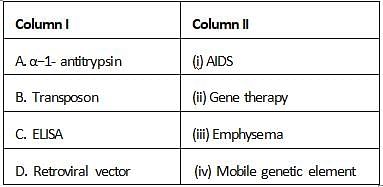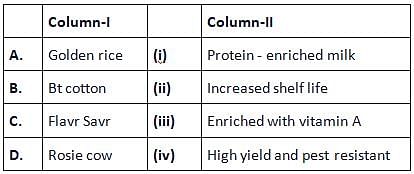Test: Transgenic Animals (NCERT) - NEET MCQ
10 Questions MCQ Test Biology Class 12 - Test: Transgenic Animals (NCERT)
Select the correct options to fill up the blanks.
(i) _____ enzyme is crucial for the immune system to function and its absence is caused by the deletion of a gene
(ii) Insulin consists of _____ and _____ that are linked together by _____
(iii) Transgenic mice are being used to test the safety of the ____
(iv) _____ involves silencing of a specific mRNA due to a complementary dsRNA molecule that binds to and prevents translation of the mRNA
(i) _____ enzyme is crucial for the immune system to function and its absence is caused by the deletion of a gene
(ii) Insulin consists of _____ and _____ that are linked together by _____
(iii) Transgenic mice are being used to test the safety of the ____
(iv) _____ involves silencing of a specific mRNA due to a complementary dsRNA molecule that binds to and prevents translation of the mRNA
Animals that have had their DNA manipulated to possess and express a foreign gene are called
A human protein which is being obtained from transgenic animals and is used to treat emphysema is
Which of the following is not a benefit of transgenic animals?
Match column I with column II and seclect the correct option from the given codes

Match column I containing transgenic organisms with their specific characteristics in column II and select the correct option from the given codes.

Read the given statements and select the correct option.
Statement 1: Transgenic mouse is termed as 'super mouse' because it is twice big in size than the normal mouse.
Statement 2: In 'super mouse', the gene for human growth factor has been introduced and expressed.
Genetic engineering has been successfully used for producing
|
78 videos|277 docs|174 tests
|




















